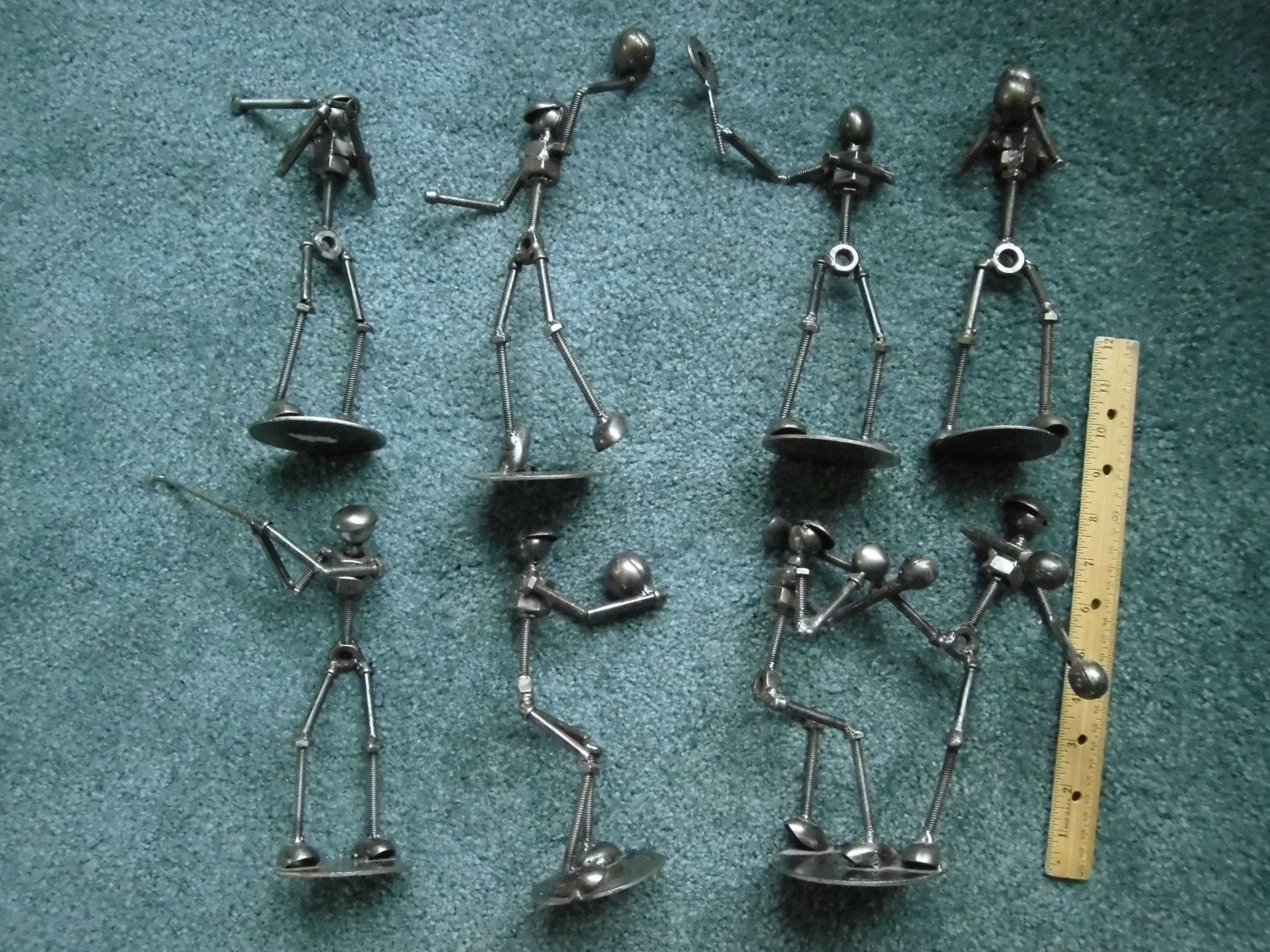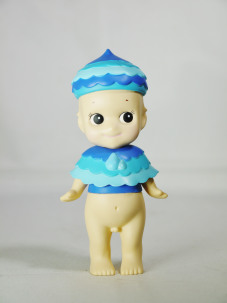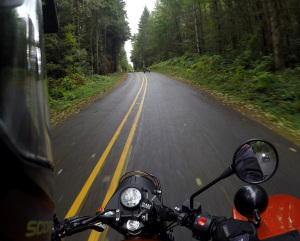 Forget everything you know about riding and focus on one thing: what it felt like to ride a motorcycle for the very first time. The world is zipping past you in a blur; meanwhile you’re trying to keep your eyes on the road, desperately scanning for the next obstacle while simultaneously trying to tame the machine with each of your appendages. I nearly forgot what that felt like, but after commuting through downtown Seattle astride a Russian rig, I have a renewed sense of appreciation for “first timers”. Take my word for it, riding a sidecar is an experience like no other.
Forget everything you know about riding and focus on one thing: what it felt like to ride a motorcycle for the very first time. The world is zipping past you in a blur; meanwhile you’re trying to keep your eyes on the road, desperately scanning for the next obstacle while simultaneously trying to tame the machine with each of your appendages. I nearly forgot what that felt like, but after commuting through downtown Seattle astride a Russian rig, I have a renewed sense of appreciation for “first timers”. Take my word for it, riding a sidecar is an experience like no other.
Way back in February, I wrote about a late winter excursion down to the Bluegrass State. Beyond detailing my twisty adventure, that post was also part of my entry for the Rever #WinterBeDamned Challenge. As it turns out, based on my blog and social media effort, I was ultimately selected as the winner of the contest’s grand prize. For folks unfamiliar, the grand prize was round trip airfare to Seattle and an afternoon of riding a Ural sidecar accompanied by a Ural factory rider. Long time readers of the blog are already familiar with my affinity for the Ural. Beyond winning a “weekend vacation”, I was finally going to get the opportunity to ride a sidecar (or is that “drive”?), and see if it truly is the “365 day solution” that I think it is.
Ural Headquarters
 Touching down in Seattle is was like 55° F and raining; seemed like stereotypical fall weather in the Pacific Northwest from what I’d heard. The next morning, Vice President of Operations, Jason Rae, picked me up from the hotel and gave me a short tour of the national headquarters in Redmond. Needless to say I had a lot of questions, and throughout the day I picked up a lot of history, not just about the bikes, but also about the company. Prior to my visit I was under the impression that the company was based in Russia and imported into the United States; in reality, IMZ-Ural is now owned in the U.S., while the motorcycle factory still operates in Siberia.
Touching down in Seattle is was like 55° F and raining; seemed like stereotypical fall weather in the Pacific Northwest from what I’d heard. The next morning, Vice President of Operations, Jason Rae, picked me up from the hotel and gave me a short tour of the national headquarters in Redmond. Needless to say I had a lot of questions, and throughout the day I picked up a lot of history, not just about the bikes, but also about the company. Prior to my visit I was under the impression that the company was based in Russia and imported into the United States; in reality, IMZ-Ural is now owned in the U.S., while the motorcycle factory still operates in Siberia. I had an inkling that the staff in Seattle was pretty small, in fact there are only about a dozen employees at the U.S. headquarters, steering the business worldwide. I also had no idea that Ural only builds about 1,400 units each year, with about half of those being sold in the U.S. annually. From the moment I shook hands with Jason and David George (head of Ural Sales and Product Support), my tour guides for the afternoon, I realized that Ural is like a family, and that family extends to its customers.
I had an inkling that the staff in Seattle was pretty small, in fact there are only about a dozen employees at the U.S. headquarters, steering the business worldwide. I also had no idea that Ural only builds about 1,400 units each year, with about half of those being sold in the U.S. annually. From the moment I shook hands with Jason and David George (head of Ural Sales and Product Support), my tour guides for the afternoon, I realized that Ural is like a family, and that family extends to its customers.
After the tour, and spending a few moments meeting the other folks around the office, David gave me a crash course on sidecar basics. I had a vague familiarity, considering my previous visits to the local Dayton dealer, Heindle Engineering, but it’s completely different when you’re moments away from getting the keys to a brand new Gear Up sidecar for the day. 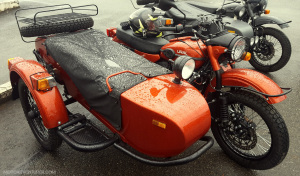 David pointed out what little effort it takes to pick up the chair, as he effortlessly lifted the sidecar into the air despite me sitting in the saddle. With the slightest lean over the hack, the weight shift is enough to force the chair back down, but it served as a good lesson for what I was about to experience. After a few more moments of getting acquainted with the controls and just as it started to rain, we headed out to the parking lot so I could practice my steering skills.
David pointed out what little effort it takes to pick up the chair, as he effortlessly lifted the sidecar into the air despite me sitting in the saddle. With the slightest lean over the hack, the weight shift is enough to force the chair back down, but it served as a good lesson for what I was about to experience. After a few more moments of getting acquainted with the controls and just as it started to rain, we headed out to the parking lot so I could practice my steering skills.
For folks unfamiliar, unlike a traditional motorcycle, sidecars steer more like a car; if you want to go right, you turn the front wheel to the right, and vice versa. Left-hand turns, while they still require a little leaning, are relatively simple as the sidecar wheel pushes against the centrifugal force of the turn, keeping the bike upright. Right-hand turns however are the tricky ones that tend to pick up the “tub”, or “fly the chair” as they say. 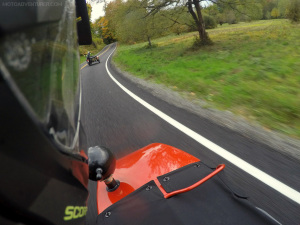 The sidecar lifting off the ground wouldn’t in itself be such a problem, if it weren’t for the fact that the action of lifting the third-wheel instantaneously converts your “normal steering” sidecar rig into a “counter steering” motorcycle; abruptly forcing you to figure out which way to push the bars to avoid careening into oncoming traffic. Circling around parking lot islands, I rapidly became familiar with the feeling of the sidecar attempting to levitate, worsening with higher speeds or tighter corners. Accustomed to flogging road manners into Rosie the Scrambler while carving through the twisties, I’m no stranger to leaning off the seat, but take my word for it, you’ve not leaned off a motorcycle until you’ve hustled a sidecar through a few curves.
The sidecar lifting off the ground wouldn’t in itself be such a problem, if it weren’t for the fact that the action of lifting the third-wheel instantaneously converts your “normal steering” sidecar rig into a “counter steering” motorcycle; abruptly forcing you to figure out which way to push the bars to avoid careening into oncoming traffic. Circling around parking lot islands, I rapidly became familiar with the feeling of the sidecar attempting to levitate, worsening with higher speeds or tighter corners. Accustomed to flogging road manners into Rosie the Scrambler while carving through the twisties, I’m no stranger to leaning off the seat, but take my word for it, you’ve not leaned off a motorcycle until you’ve hustled a sidecar through a few curves.
The 2017 Gear Up
 Ural offers several different trim levels for their sidecars, but their main staples are the M70, cT, and the Gear Up. The one-wheel drive M70 has throwback “Soviet era” styling and traditional telescopic front forks. The more “urban” cT, also equipped with one-wheel drive, has leading link front suspension and more modern styling, including a sidecar windshield. Lastly, what I consider to be Ural’s flagship motorcycle, the Gear Up; again with leading link suspension, but with selectable two wheel drive for inclement weather conditions and tailored for more “adventure” inspired buyers.
Ural offers several different trim levels for their sidecars, but their main staples are the M70, cT, and the Gear Up. The one-wheel drive M70 has throwback “Soviet era” styling and traditional telescopic front forks. The more “urban” cT, also equipped with one-wheel drive, has leading link front suspension and more modern styling, including a sidecar windshield. Lastly, what I consider to be Ural’s flagship motorcycle, the Gear Up; again with leading link suspension, but with selectable two wheel drive for inclement weather conditions and tailored for more “adventure” inspired buyers.
 While Ural has sold a traditional 2-wheeled model in the past, they currently focus on only 3-wheeled variants. Each model is powered by a 750 cc, air-cooled, flat-twin “Boxer”, with a 5-speed gearbox (4 speed plus reverse), and shaft drive. Each model also carries about 5 gallons of gas, with an estimated range of 150-185 miles, depending on “riding conditions”. Generally, a Ural weighs in around 700 pounds or so (dry), with a (recommended) cruising speed around 70 mph. Sidecar tonneau cover and power outlet are also standard on all 2017 models.
While Ural has sold a traditional 2-wheeled model in the past, they currently focus on only 3-wheeled variants. Each model is powered by a 750 cc, air-cooled, flat-twin “Boxer”, with a 5-speed gearbox (4 speed plus reverse), and shaft drive. Each model also carries about 5 gallons of gas, with an estimated range of 150-185 miles, depending on “riding conditions”. Generally, a Ural weighs in around 700 pounds or so (dry), with a (recommended) cruising speed around 70 mph. Sidecar tonneau cover and power outlet are also standard on all 2017 models.
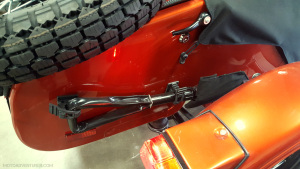 The Gear Up stands apart from the one-wheel drive variants with it selectable two-wheel drive and “Adventure” accessories. Beyond the extra “push”, the Gear Up comes with an additional “universal” 19 inch spare wheel; sidecar front bumper; LED sidecar fog lights; lockable gas tank “glovebox”; Jerry can; luggage rack; and my favorite “extra”, the folding entrenchment tool.
The Gear Up stands apart from the one-wheel drive variants with it selectable two-wheel drive and “Adventure” accessories. Beyond the extra “push”, the Gear Up comes with an additional “universal” 19 inch spare wheel; sidecar front bumper; LED sidecar fog lights; lockable gas tank “glovebox”; Jerry can; luggage rack; and my favorite “extra”, the folding entrenchment tool.
What’s new in 2017?
 I’ve been following Ural pretty closely since the big jump to EFI in 2014. Along with fuel injection, that year brought all-wheel disc brakes (did I say Brembo?), along with a hydraulic steering damper, among a myriad of other changes. Since then, Ural has made progressive upgrades to their models, including the universal spare wheel (see above), updated roller bearings for the crankshaft, and liquid paint in lieu of powder coating.
I’ve been following Ural pretty closely since the big jump to EFI in 2014. Along with fuel injection, that year brought all-wheel disc brakes (did I say Brembo?), along with a hydraulic steering damper, among a myriad of other changes. Since then, Ural has made progressive upgrades to their models, including the universal spare wheel (see above), updated roller bearings for the crankshaft, and liquid paint in lieu of powder coating.
For 2017, Ural has replaced the tractor seat with a new “enduro” bench seat, upgraded to an electronic instrument cluster, relocated the parking brake to the handlebars, installed a reverse gear foot pedal in lieu of hand lever, and added a handlebar switch for the auxiliary light(s).
The Ride
Thumbing the starter and firing up a Ural for the first time, I noticed that it tends to “spin-up” a lot like a thumper;  you hear the engine turn over a few times as it ticks up to idle. David asked me early on if I was familiar with vintage bikes, as the Ural boxer is somewhat similar in character; with straight cut gears, you need to operate the shift lever with authority and resolve. I concur, it does take a little extra “effort” to operate the gearbox, but in reality, it’s just like everything else, you get used to it, and eventually it’s just another facet of the experience. Interestingly enough, while the shifting experience is diametrically different than the buttery smooth “click” of the helical cut gears on my Triumph; despite its otherwise “agricultural” character, neutral seemed to be extremely easy to find on the Ural, something I seldom say about other bikes I’ve ridden.
you hear the engine turn over a few times as it ticks up to idle. David asked me early on if I was familiar with vintage bikes, as the Ural boxer is somewhat similar in character; with straight cut gears, you need to operate the shift lever with authority and resolve. I concur, it does take a little extra “effort” to operate the gearbox, but in reality, it’s just like everything else, you get used to it, and eventually it’s just another facet of the experience. Interestingly enough, while the shifting experience is diametrically different than the buttery smooth “click” of the helical cut gears on my Triumph; despite its otherwise “agricultural” character, neutral seemed to be extremely easy to find on the Ural, something I seldom say about other bikes I’ve ridden.
Similar to its character, looking at the engine there’s no denying it’s reminiscent of a different era. However, that’s not a dig against Ural, the technology might be “old”, but it works, and that’s part of the allure to the brand. Ural has been making big strides in recent years; making prudent changes to their components, while still being true to the brand. “Simplicity” is unquestionably the second biggest reason I’m interested in a Ural; two-wheel drive being the first. Overall there’s no denying that fit and finish has been improved year after year since 2014. I have often found Urals sold on showrooms next to Royal Enfield; by comparison, you’ll notice poor quality casting marks and welds on the Indian built Bullet, while the Ural doesn’t have such blemishes. The bike may have an “agricultural” feel, but the machine’s details are very much modern.
Ural has been making big strides in recent years; making prudent changes to their components, while still being true to the brand. “Simplicity” is unquestionably the second biggest reason I’m interested in a Ural; two-wheel drive being the first. Overall there’s no denying that fit and finish has been improved year after year since 2014. I have often found Urals sold on showrooms next to Royal Enfield; by comparison, you’ll notice poor quality casting marks and welds on the Indian built Bullet, while the Ural doesn’t have such blemishes. The bike may have an “agricultural” feel, but the machine’s details are very much modern.
In contrast to the somewhat old-fashioned gearbox, the throttle response was buttery smooth, with very linear power delivery. That smooth power delivery becomes critical when maneuvering the rig, but I’ll talk more about that in a minute. Unbeknownst to me prior to writing this, the Ural actually has a dry clutch. Somewhat of a rarity on most motorcycles these days,  I’ve heard several Ducati Hypermotards with dry clutches, along with custom Harleys with open primaries, but at no point throughout the entire day did I notice anything, sound or function, that indicated a dry clutch hidden inside the Russian mill. Trying to adjust to all the changes as once, I was initially worried I might be winding out the engine too far considering I didn’t have a tachometer. David reassured me that winding it out was good, “lugging” the engine was what I wanted to avoid (there’s also a rev limiter to keep you from getting too crazy). That seemed easy enough for me, as I would say that I consider that a “normal” practice for me, but I wanted to at least check considering I’d never experienced a bike like the Ural before.
I’ve heard several Ducati Hypermotards with dry clutches, along with custom Harleys with open primaries, but at no point throughout the entire day did I notice anything, sound or function, that indicated a dry clutch hidden inside the Russian mill. Trying to adjust to all the changes as once, I was initially worried I might be winding out the engine too far considering I didn’t have a tachometer. David reassured me that winding it out was good, “lugging” the engine was what I wanted to avoid (there’s also a rev limiter to keep you from getting too crazy). That seemed easy enough for me, as I would say that I consider that a “normal” practice for me, but I wanted to at least check considering I’d never experienced a bike like the Ural before.
With David convinced I was comfortable with leaning into the turns around the parking lot, we headed back to the office to pick up Jason and head out of the city in search of some backroads. Originally Jason had planned on an eastern route up through the mountains; unfortunately with fall weather it was actually snowing at elevation that morning so he decided it was best to stick with a ride on the far side of Puget Sound. Finally filtering into Seattle traffic, I was immediately surprised by the Ural’s gearing; slowing for traffic lights, without pulling in the clutch I could squeeze the brakes until nearly at a full stop before the engine even hinted that it might stall.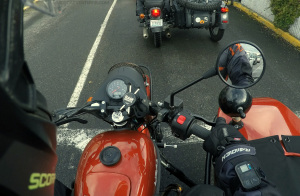 Meanwhile, with a flat torque curve that pulls right out of the basement, pulling away from a stoplight pretty effortless; aside from a little dose of “sidecar physics”. Related to the previous comment about vintage bikes, this was my first (motorcycle) experience with a 4-speed transmission. First and second gear were impressively tall, David mentioned you could feasibly start the bike in second; I found myself typically cruising the service streets in second, and only clicking into third in the higher speed limits.
Meanwhile, with a flat torque curve that pulls right out of the basement, pulling away from a stoplight pretty effortless; aside from a little dose of “sidecar physics”. Related to the previous comment about vintage bikes, this was my first (motorcycle) experience with a 4-speed transmission. First and second gear were impressively tall, David mentioned you could feasibly start the bike in second; I found myself typically cruising the service streets in second, and only clicking into third in the higher speed limits.
As we started to find our way onto secondary streets my attention shifted from avoiding traffic to noticing the character of the rig. 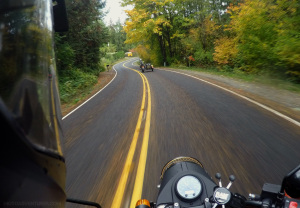 Cruising down the roadway I began to notice the bike “do the worm” with bends in the road and changes in steering. Needless to say that’s a really odd feeling as you pull the bars to follow the curve in the road and then literally feel the tub “react” to the inputs. I didn’t understand this strange sensation at first, and then it occurred to me: the sidecar wheel is in a unique position, not in line with the other two, while there’s also an asymmetrical weight distribution, putting the center of gravity somewhere between the bike and the hack; a sidecar simply “moves” in a way like no other vehicle I’ve ridden in or on. As the day went on I noticed the sensation less and less as I began to acclimate with the “flow” of the bike.
Cruising down the roadway I began to notice the bike “do the worm” with bends in the road and changes in steering. Needless to say that’s a really odd feeling as you pull the bars to follow the curve in the road and then literally feel the tub “react” to the inputs. I didn’t understand this strange sensation at first, and then it occurred to me: the sidecar wheel is in a unique position, not in line with the other two, while there’s also an asymmetrical weight distribution, putting the center of gravity somewhere between the bike and the hack; a sidecar simply “moves” in a way like no other vehicle I’ve ridden in or on. As the day went on I noticed the sensation less and less as I began to acclimate with the “flow” of the bike.
I’ve read about the characteristics of sidecar “piloting” in quite a few other Ural reviews. Most writers mention that you feel the sidecar lag with acceleration and surge forward when under braking. Contrary to that statement, I actually found those acts to be relatively uneventful compared to what I’d expected; I found that it was only prevalent with poorly executed shifts; as long as I managed to shift smoothly, the ride was (generally) linear. With regard to braking,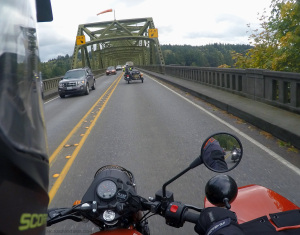 there’s no denying that the rig has a tendency to push left when exclusively using the front brake. The rear and sidecar brakes are actually linked with the right foot pedal; so inversely, when only using the “rear” brakes, the sidecar has a tendency to track to the right. Using a balanced application of both brakes, I found that the Gear Up slowed in a perfectly straight line. David reassured me that that’s how a properly set up sidecar should behave; there’s actually a rear brake “bias” that can be adjusted to fine-tune the braking if needed. On the other hand, what really surprised me was the amount of effort needed to “steer” the rig around the corners. It makes sense though, the weight difference of a sidecar versus a motorcycle, and all of that asymmetrical weight being hinged on the front wheel. This effort is compounded by the fact you are leaning into the turn, yet pulling on the bars. On a standard two-wheeled motorcycle you lean into the curve, and the act of doing so actually helps you push the bars, counter-steering the motorcycle into the desired direction. Extra effort aside, the entire act takes a bit of getting used to as you initially feel “crossed-up” trying to maneuver the machine.
there’s no denying that the rig has a tendency to push left when exclusively using the front brake. The rear and sidecar brakes are actually linked with the right foot pedal; so inversely, when only using the “rear” brakes, the sidecar has a tendency to track to the right. Using a balanced application of both brakes, I found that the Gear Up slowed in a perfectly straight line. David reassured me that that’s how a properly set up sidecar should behave; there’s actually a rear brake “bias” that can be adjusted to fine-tune the braking if needed. On the other hand, what really surprised me was the amount of effort needed to “steer” the rig around the corners. It makes sense though, the weight difference of a sidecar versus a motorcycle, and all of that asymmetrical weight being hinged on the front wheel. This effort is compounded by the fact you are leaning into the turn, yet pulling on the bars. On a standard two-wheeled motorcycle you lean into the curve, and the act of doing so actually helps you push the bars, counter-steering the motorcycle into the desired direction. Extra effort aside, the entire act takes a bit of getting used to as you initially feel “crossed-up” trying to maneuver the machine.
Before we had left the parking lot David made a very conscious effort to remind me to be aware of the far right wheel position. 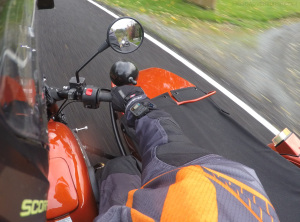 He said they deal with more dents and dings on the sidecar fender than any other issue with their demo bikes; he mentioned that non-sidecar riders are unaccustomed to how wide the Ural really is and accidentally bump the hack into fixed objects around corners. Following Jason, I Initially found it easy to stay “left adjusted” in the lane as we worked our way out of the city. As we finally found ourselves on more of the twisty bits, I realized how habitual that “outside-inside-outside” motorcycle line through the curves is ingrained in your muscle memory. I did fortunately avoid dropping the sidecar wheel off the roadway for the entirety of the afternoon, but there were still a few times that needed to adjust my line and tell myself “no” when going around the bends; even more so in tight parking lots as it turns out.
He said they deal with more dents and dings on the sidecar fender than any other issue with their demo bikes; he mentioned that non-sidecar riders are unaccustomed to how wide the Ural really is and accidentally bump the hack into fixed objects around corners. Following Jason, I Initially found it easy to stay “left adjusted” in the lane as we worked our way out of the city. As we finally found ourselves on more of the twisty bits, I realized how habitual that “outside-inside-outside” motorcycle line through the curves is ingrained in your muscle memory. I did fortunately avoid dropping the sidecar wheel off the roadway for the entirety of the afternoon, but there were still a few times that needed to adjust my line and tell myself “no” when going around the bends; even more so in tight parking lots as it turns out.
Settling into a groove, I began enjoying the scenery and taking more mental notes about the Ural. The seating position is neutral, with your feet slightly forward and the bars easily within reach; it’s actually very similar to my Triumph. 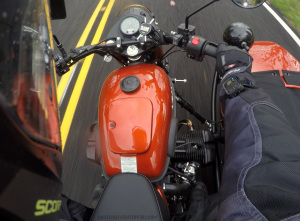 I admit, when you first mount the saddle, you think your toes will be mashed right up against the jugs, but after spending all day on the bike, that’s really not the case. I was impressed to find that the seat was indeed “all-day” comfortable; it seemed a bit “firm” after riding all afternoon, however having experienced some painful lessons from the Scrambler’s stock bench, I agree that starting out firm is a good thing. From some of David’s comments, I suspect that the new enduro seat will “form to the owner” with time and make it that much more comfortable. That extra space provided by the two-up bench was also welcome; when things got sporty I found myself hugging the tank and leaning off the seat, but when touring on the lazy roads it was convenient to scoot back on the seat, spread out, and relax.
I admit, when you first mount the saddle, you think your toes will be mashed right up against the jugs, but after spending all day on the bike, that’s really not the case. I was impressed to find that the seat was indeed “all-day” comfortable; it seemed a bit “firm” after riding all afternoon, however having experienced some painful lessons from the Scrambler’s stock bench, I agree that starting out firm is a good thing. From some of David’s comments, I suspect that the new enduro seat will “form to the owner” with time and make it that much more comfortable. That extra space provided by the two-up bench was also welcome; when things got sporty I found myself hugging the tank and leaning off the seat, but when touring on the lazy roads it was convenient to scoot back on the seat, spread out, and relax.
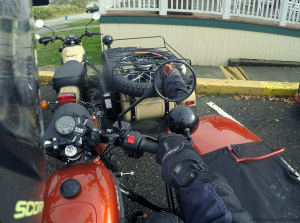
After a ferry ride across Puget Sound, we stopped for lunch in Port Gamble, where I parked the Gear Up in a spot pointing downhill. At 730 pounds, without gas or my own heft, the Ural is obviously not light for a 750; fortunately it comes with reverse. This probably doesn’t sound strange, as reverse is becoming more and more popular on the big baggers like the Gold Wing, and even the new BMW K1600 GTL. The Ural however is different, while many motorcycles utilize the starter motor to actuate a reverse function, 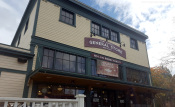 the Ural’s reverse gear is actually a part of the transmission, so you still use the clutch and throttle. From Neutral, there is a foot pedal you actuate for reverse gear, after that, look behind you, let out the clutch and give it a little gas; just a seamless as a backing out a car. Press the right foot lever back into neutral, and you’re ready to head out.
the Ural’s reverse gear is actually a part of the transmission, so you still use the clutch and throttle. From Neutral, there is a foot pedal you actuate for reverse gear, after that, look behind you, let out the clutch and give it a little gas; just a seamless as a backing out a car. Press the right foot lever back into neutral, and you’re ready to head out.
After a platter of fish ‘n chips and warming up a bit, we set back out to find a few more twisty roads. By that point I was feeling pretty comfortable with my sidecar piloting skills and looking forward to challenging myself with some tighter curves. Headed south toward Bainbridge Island, the sun finally came out and the roads dried off a bit. Pulling on the bars and leaning over the sidecar with a little extra effort, I hustled the Gear Up through the bends of the forest lined streets.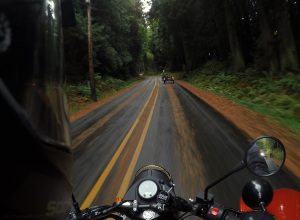 Several times I noted the profuse amounts of pine needles and grass clippings covering the roadway in the shade, exposing only a pair of narrow wheel tracks where a few cars had recently passed through. At that moment I realized, this road would’ve been absolutely treacherous on a two-wheeled motorcycle, but the Ural was right at home; confidence inspiring by comparison.
Several times I noted the profuse amounts of pine needles and grass clippings covering the roadway in the shade, exposing only a pair of narrow wheel tracks where a few cars had recently passed through. At that moment I realized, this road would’ve been absolutely treacherous on a two-wheeled motorcycle, but the Ural was right at home; confidence inspiring by comparison.
From Bainbridge Island it was another ferry ride, this time right into the heart of Seattle. 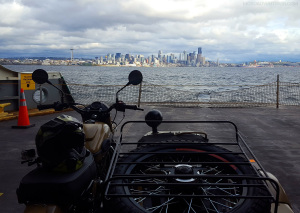 As the ferry “turned the corner” around a point, I could see the Seattle skyline emerge from behind a line of pine trees; I regret that a photo simply doesn’t do it justice. Pulling into port with the sun shining, we passed a number of motorcyclists waiting to get across the sound as the weather was breaking and the work day was ending. Merging into the city I was suddenly reminded of Cincinnati; while Amazon and Microsoft call Seattle home, I still felt a blue-collar vibe downtown, but the pub district and side-by-side sports stadiums really framed that comparison for me.
As the ferry “turned the corner” around a point, I could see the Seattle skyline emerge from behind a line of pine trees; I regret that a photo simply doesn’t do it justice. Pulling into port with the sun shining, we passed a number of motorcyclists waiting to get across the sound as the weather was breaking and the work day was ending. Merging into the city I was suddenly reminded of Cincinnati; while Amazon and Microsoft call Seattle home, I still felt a blue-collar vibe downtown, but the pub district and side-by-side sports stadiums really framed that comparison for me.
Headed south toward I-90, we took the freeway east of the city to pick up a few more backroads before it was time to call it a day.  I was honestly shocked by how easy it was to ride the Ural on the highway. Things that I had read made it sound like you would never want to take a Ural on the interstate, but I can assure you, that’s not the case with a modern Ural.
I was honestly shocked by how easy it was to ride the Ural on the highway. Things that I had read made it sound like you would never want to take a Ural on the interstate, but I can assure you, that’s not the case with a modern Ural.  No, you’re not going to set any speed records; yes, you need to have plans to pass people and be prepared to be relegated to the right two lanes at times. That said, I found the Ural to be surprisingly comfortable at speed, and at no point did I feel like the Siberian 750 was strung out. I will say that I can see an argument for a windscreen; longtime readers know that I really don’t subscribe to that kind of thinking, so I was reasonably comfortable despite the wind blast, but I can see the appeal for some folks.
No, you’re not going to set any speed records; yes, you need to have plans to pass people and be prepared to be relegated to the right two lanes at times. That said, I found the Ural to be surprisingly comfortable at speed, and at no point did I feel like the Siberian 750 was strung out. I will say that I can see an argument for a windscreen; longtime readers know that I really don’t subscribe to that kind of thinking, so I was reasonably comfortable despite the wind blast, but I can see the appeal for some folks.
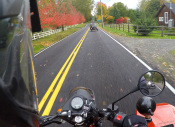 Somewhere around Fall City we found a good long set of twisty backroads. Littered with quaint cottages, pine trees, and a spattering of fall color, the bends along Issaquah-Fall City Road were the best of the whole trip.
Somewhere around Fall City we found a good long set of twisty backroads. Littered with quaint cottages, pine trees, and a spattering of fall color, the bends along Issaquah-Fall City Road were the best of the whole trip. 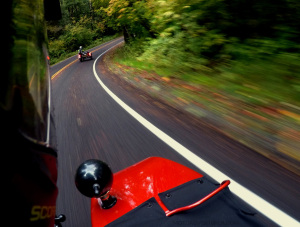 I had finally started to feel confident with my skill at keeping the chair on the ground while hustling through the curves and I was begging for more; right about that time, we were descending on Redmond to hang it up for the day. Pulling back into the shop I had a million questions and was still trying to digest everything that had happened in such a short period of time.
I had finally started to feel confident with my skill at keeping the chair on the ground while hustling through the curves and I was begging for more; right about that time, we were descending on Redmond to hang it up for the day. Pulling back into the shop I had a million questions and was still trying to digest everything that had happened in such a short period of time.
The Pacific Northwest
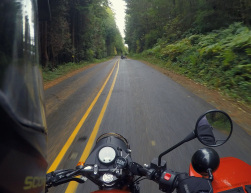
Seattle is a gorgeous city; riding a Ural in the Pacific Northwest really makes the experience that much better. Beyond the Ural staff, folks in Seattle were very outgoing and extremely friendly; much different than what I have experienced in Chicago, San Diego, and even parts of Ohio for that matter. You can watch movies about the Pacific Northwest, but there’s nothing like seeing it in person; everything is green, from the pine trees to the moss growing on the jersey barriers, it’s very much alive. 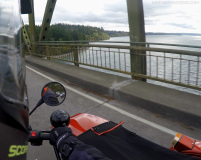 They don’t call it the Emerald City for nothing. My time in the city was unfortunately way too short, I was hoping to catch a good view of the mountains, but weather wasn’t exactly cooperating; what I did see was already outstanding, I can only imagine the views at elevation. I told Jason and David before I left, now that I’ve seen Washington State, it’s going to be very difficult to keep me from returning.
They don’t call it the Emerald City for nothing. My time in the city was unfortunately way too short, I was hoping to catch a good view of the mountains, but weather wasn’t exactly cooperating; what I did see was already outstanding, I can only imagine the views at elevation. I told Jason and David before I left, now that I’ve seen Washington State, it’s going to be very difficult to keep me from returning.
I want a Ural Gear Up
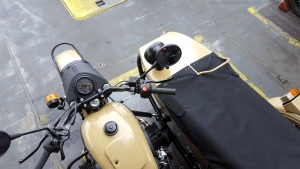 Sidecars are icons from a different era, I find it ironic that my initial interest in a sidecar was predominantly to avoid the mundane “comfort” of the modern automobile, and the hustle and bustle of city life; fitting I suppose as the Ural is a “time machine” in many ways. Initially I saw it as a means to an end; a utilitarian machine that lets me ride a motorcycle year-round despite Midwestern winters, while also having the ability to load it up with groceries, or to pick up a friend and go see a movie. My obsession with ditching the car for a “simpler life” never seemed that “deep” until I looked at it in that light.
Sidecars are icons from a different era, I find it ironic that my initial interest in a sidecar was predominantly to avoid the mundane “comfort” of the modern automobile, and the hustle and bustle of city life; fitting I suppose as the Ural is a “time machine” in many ways. Initially I saw it as a means to an end; a utilitarian machine that lets me ride a motorcycle year-round despite Midwestern winters, while also having the ability to load it up with groceries, or to pick up a friend and go see a movie. My obsession with ditching the car for a “simpler life” never seemed that “deep” until I looked at it in that light.
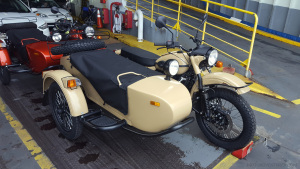 I regret that I didn’t get an opportunity to test the two-wheel drive. David gave me a short tutorial on how it works when we were parked at the office. He explained the importance of only using two-wheel drive in inclement conditions, as one wheel will always need to be in a “slip” condition. See, the Ural doesn’t have a differential like most four-wheel drive cars; so when you throw the Gear Up into two-wheel drive, the sidecar wheel is locked in step with the main drive wheel. That may not sound like an issue at first, but ultimately that second drive wheel will overpower the steering on dry pavement; when both “rear” wheels are pushing the rig and you go to turn, the Ural just keeps going straight.
I regret that I didn’t get an opportunity to test the two-wheel drive. David gave me a short tutorial on how it works when we were parked at the office. He explained the importance of only using two-wheel drive in inclement conditions, as one wheel will always need to be in a “slip” condition. See, the Ural doesn’t have a differential like most four-wheel drive cars; so when you throw the Gear Up into two-wheel drive, the sidecar wheel is locked in step with the main drive wheel. That may not sound like an issue at first, but ultimately that second drive wheel will overpower the steering on dry pavement; when both “rear” wheels are pushing the rig and you go to turn, the Ural just keeps going straight.
That aside, the Gear Up does indeed seem to be the utilitarian machine I hoped it would be. I’ve heard people describe the Ural as antiquated, slow, and even unreliable; but after what I’ve seen, I wouldn’t use those words to describe the Ural. 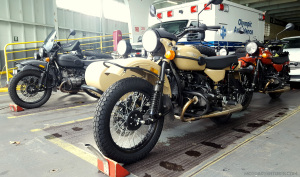 Yes, the engine is small in comparison to its weight; but it is simple, and easy to maintain. The Ural mill runs on conventional 20W50 motor oil (5W40 for colder climates), and I’m told an experienced Ural owner can do a valve adjustment in a matter of minutes (there are perks to exposed heads). Yes, service intervals are short (just over 3,000 miles), however this is a 700 pound pushrod machine, running straight cut gears, conventional oil, and can haul around the weight a Gold Wing, including passenger. The bike comes with a fuel can, a shovel, mud flaps, and has over a twenty-one gallon trunk; not to mention the extra space in the tub without the passenger, and the empty pillion seat.
Yes, the engine is small in comparison to its weight; but it is simple, and easy to maintain. The Ural mill runs on conventional 20W50 motor oil (5W40 for colder climates), and I’m told an experienced Ural owner can do a valve adjustment in a matter of minutes (there are perks to exposed heads). Yes, service intervals are short (just over 3,000 miles), however this is a 700 pound pushrod machine, running straight cut gears, conventional oil, and can haul around the weight a Gold Wing, including passenger. The bike comes with a fuel can, a shovel, mud flaps, and has over a twenty-one gallon trunk; not to mention the extra space in the tub without the passenger, and the empty pillion seat. Did I mention this is a 750? Urals are shipped with a tool kit that can handle 99.9% of the maintenance you do on the bike, along with a service manual that has actual photos of the before mentioned routine maintenance; neither of which can I find in any other brand’s dealership that I’m aware of. Look, in the end, the Ural is the motorcycle equivalent of a tractor, and it attracts a completely different kind of rider; it’s not about speed and modern amenities, it’s about the experience. David told me they have a motto, “Adventure Together” and “Adventure Daily”; that motto is unquestionably the spirit of the bike, and there’s no doubt that spirit is instilled in its owners.
Did I mention this is a 750? Urals are shipped with a tool kit that can handle 99.9% of the maintenance you do on the bike, along with a service manual that has actual photos of the before mentioned routine maintenance; neither of which can I find in any other brand’s dealership that I’m aware of. Look, in the end, the Ural is the motorcycle equivalent of a tractor, and it attracts a completely different kind of rider; it’s not about speed and modern amenities, it’s about the experience. David told me they have a motto, “Adventure Together” and “Adventure Daily”; that motto is unquestionably the spirit of the bike, and there’s no doubt that spirit is instilled in its owners.  Having a Ural means you can go almost anywhere, sent on your journey with the tools to combat whatever obstacles you may encounter; assuming you’re the intrepid type to venture off the beaten path. The best part is, you get to share the journey with someone beside you, be it your spouse, your best friend, or even your four-legged family members. If packing up your life and wandering into the great unknown, with low technology and no deadlines, sounds like your kind of adventure, than a Ural might be for you.
Having a Ural means you can go almost anywhere, sent on your journey with the tools to combat whatever obstacles you may encounter; assuming you’re the intrepid type to venture off the beaten path. The best part is, you get to share the journey with someone beside you, be it your spouse, your best friend, or even your four-legged family members. If packing up your life and wandering into the great unknown, with low technology and no deadlines, sounds like your kind of adventure, than a Ural might be for you.
I’ve heard others say it, once you’ve spent a day on a Ural, there’s something about it that simply grows on you. It’s not a performance machine, it’s not drenched in techno-wiz-bangery, it is simplicity at its finest, and it’s an unsuspectingly good time. Longtime readers of the blog already know, I’ve been attracted to the Ural for its utility, but I was also undeniably caught off guard by its charm. With the character of the engine, and the way it “moves” when you ride, the bike is “alive” in a way I’ve never experienced before. The bike not only grabs the attention of the rider, but also the public. What people say is true, you can’t ride a Ural anywhere without people stopping to talk to you.
it’s not drenched in techno-wiz-bangery, it is simplicity at its finest, and it’s an unsuspectingly good time. Longtime readers of the blog already know, I’ve been attracted to the Ural for its utility, but I was also undeniably caught off guard by its charm. With the character of the engine, and the way it “moves” when you ride, the bike is “alive” in a way I’ve never experienced before. The bike not only grabs the attention of the rider, but also the public. What people say is true, you can’t ride a Ural anywhere without people stopping to talk to you.  I always makes jokes about “The Triumph Effect”, as grey-beards see my Scrambler at the gas station and stop to tell me about their old 650 Bonneville; the “Ural Delay Factor” is even more prevalent. It’s no longer just motorcyclists that stop you, it’s every passerby you can imagine, soccer moms and all; everyone is fascinated by sidecars. And they should be, it’s unquestionably the most fun I’ve ever had at 35 miles an hour.
I always makes jokes about “The Triumph Effect”, as grey-beards see my Scrambler at the gas station and stop to tell me about their old 650 Bonneville; the “Ural Delay Factor” is even more prevalent. It’s no longer just motorcyclists that stop you, it’s every passerby you can imagine, soccer moms and all; everyone is fascinated by sidecars. And they should be, it’s unquestionably the most fun I’ve ever had at 35 miles an hour.
Now there’s only one question, can the Gear Up handle eastern Kentucky adventure trails?
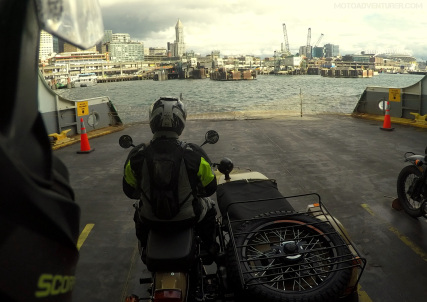

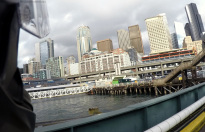





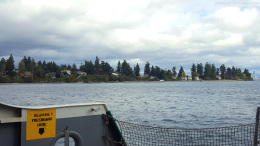
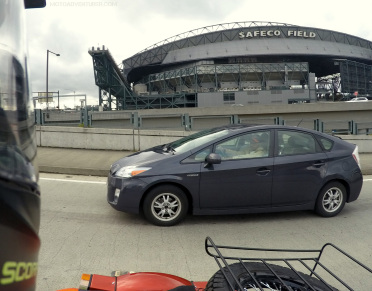

 Rate this:Share this:
Rate this:Share this:
